SEO and CRO are two marginally different strategies with differing measures of success. However they complement each other for a comprehensive growth strategy. SEO is a long term play with results materializing in up to a year. CRO, on the other hand, can see results much faster within 1-2 months.
Combining SEO and CRO efforts results in more conversions, leads, and organic sessions which means more growth for your business. On average, content marketing costs 62% less than traditional marketing but generates 3x more leads. This means when you focus on driving growth with SEO and CRO working together, you’re getting a higher ROI on your marketing efforts, and see results much faster than other marketing channels.
SEO vs CRO: How They Work to Drive Website Growth
SEO is the method of optimizing a page or a website to better align to user experience and organic search algorithm ranking factors. CRO refers to the process of optimizing conversion rate by testing and monitoring user engagement performance and making changes accordingly. CRO relies on UX design and AB testing to determine the most effective way to persuade the user to take action while on the page, while SEO primarily focuses on improving organic traffic and visibility in search results.
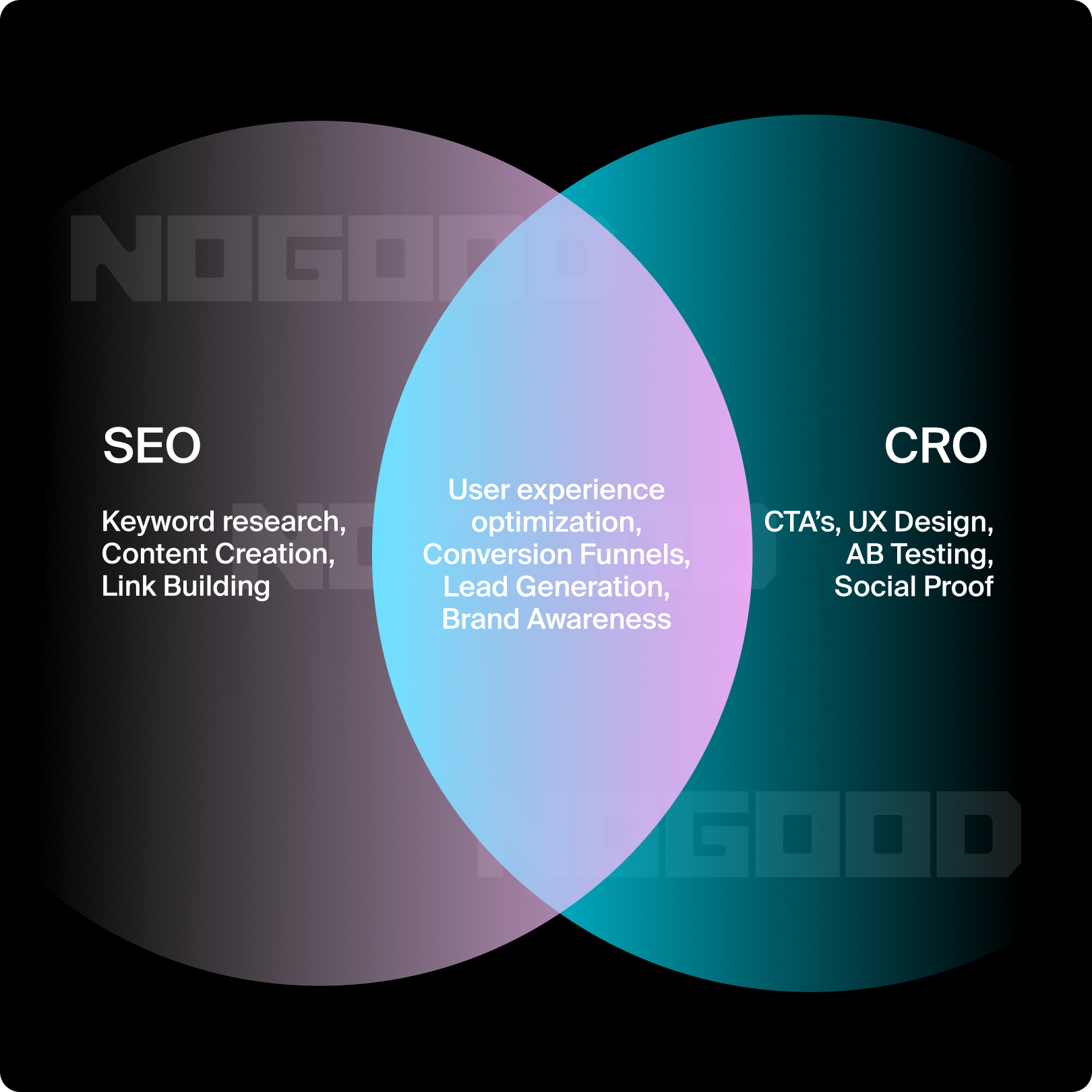
SEO Working Independently
SEO gets the user to click and remain on the page for as long as possible. We do this through keyword research and high-quality content creation, which allows our pages to be discoverable in search results. Then, once we have the user on the page, we add value through helpful content. If users find our content interesting and helpful, they will likely continue scrolling and even click through to other pages on our site. Through link building, we increase our site authority and make it easier for users and search engines to find our content.
CRO Working Independently
CRO relies on UX design and AB testing to determine the most effective way to persuade the user to take action while on the page. We can implement CTAs and social proof at different points on the page, change how they appear, and revise the copy, then run AB testing to determine which components yield the most conversions.
Need help optimizing your website for conversions?
User Behavior Principles That Influence SEO and CRO
1. Social Proof
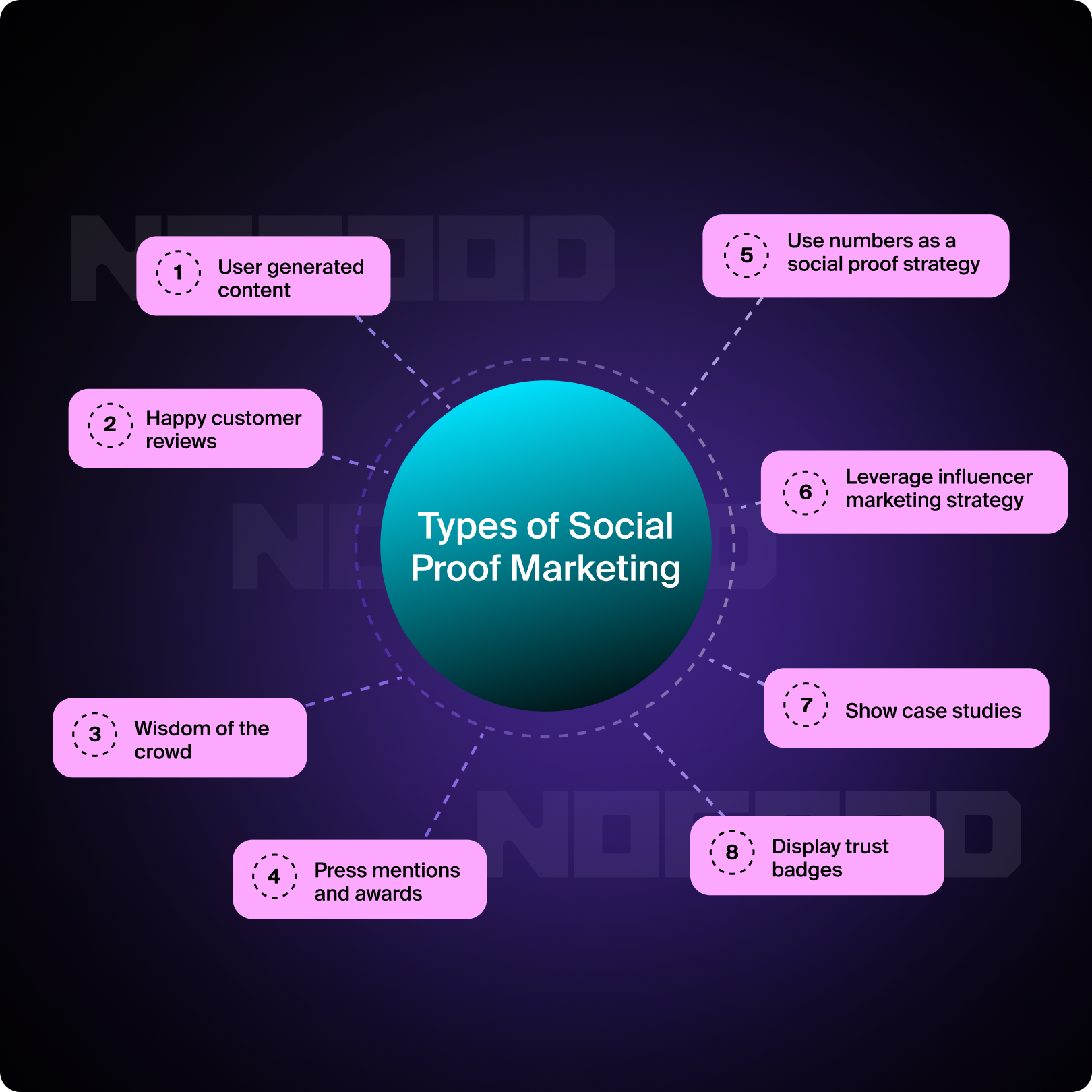
Social proof is one of the most common examples of behavioral psychology used in marketing. We see it everywhere, from reviews and ratings to video testimonials. It all comes down to the basic principle that if a large number of people hold a view or opinion about something, that belief is more likely to be true.
If I want to purchase a new cookware set for my kitchen and during my search see a set that has 8,000 reviews and 4.8 stars and a set with 14,000 reviews and 5.0 stars. I’ll compare both options and read some of the reviews. If I see reviews from people who describe using the cookware in a similar way to how I would use them, I may trust the perspective of the person leaving that review and, therefore, be more likely to purchase the set from that brand.
Social proof can also swing the other way as well. If I look at the cookware set with 14,000 reviews and 5.0 stars, I may have some skepticism if I don’t see any critical reviews of the set. So I would go back to the cookware set with 4.8 stars and consider some of the factors that led to lower ratings.
Perhaps some customers found the pots and pans too heavy, or they felt the cookware was better for use on a gas stove rather than electric. Now, I can consider these factors to determine how they might affect my experience with the cookware set. This helped to inform my decision much more than the other brand, which had more reviews, but none of them were critical.
2. Fast and Slow Thinking
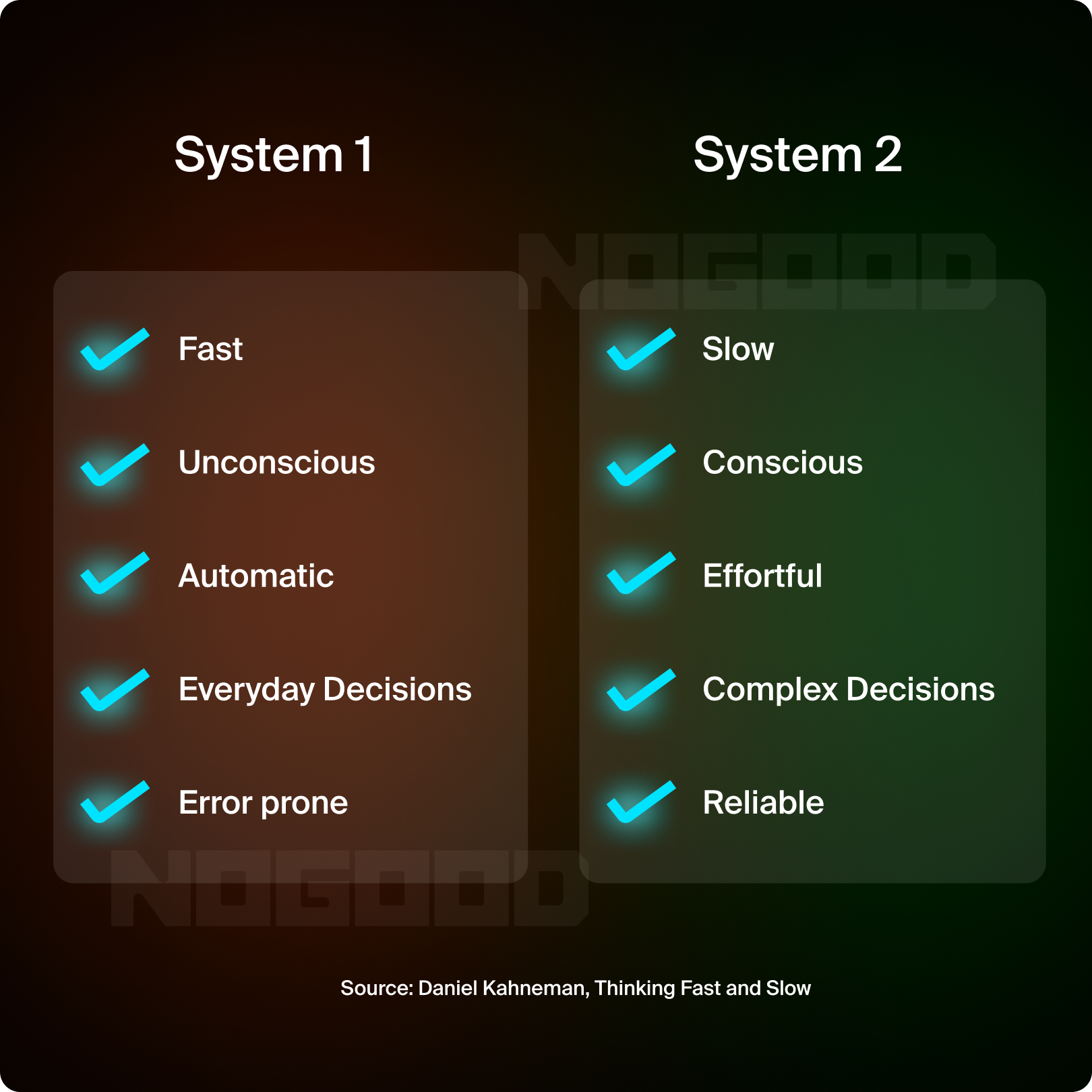
Fast and slow thinking are fundamental to how we make decisions. Fast thinking is based on emotions, while slow thinking is rooted in logic and reason.
When this principle is applied to web design, images, fonts, colors, and videos evoke fast thinking as they play on the user’s emotions. Tech specs, informational snippets, and blog posts encourage slow thinking.
Let’s say I’m looking for a new blender, I’ll go to the product pages of some top rated blenders. Product pages typically have a good balance of images and technical descriptions.
The images capture my attention and show me how nice the blender looks in a kitchen and the delicious food I can make with it, evoking fast thinking and encouraging me to add it to my cart. If I scroll down to the features, slow thinking kicks in, and I rationalize my decision by considering how tech specs will influence how the blender will perform.
A product page that allows me to use fast and slow thinking makes me feel as though I am making a well thought out decision because I have used both logic and emotion.
3. Scarcity
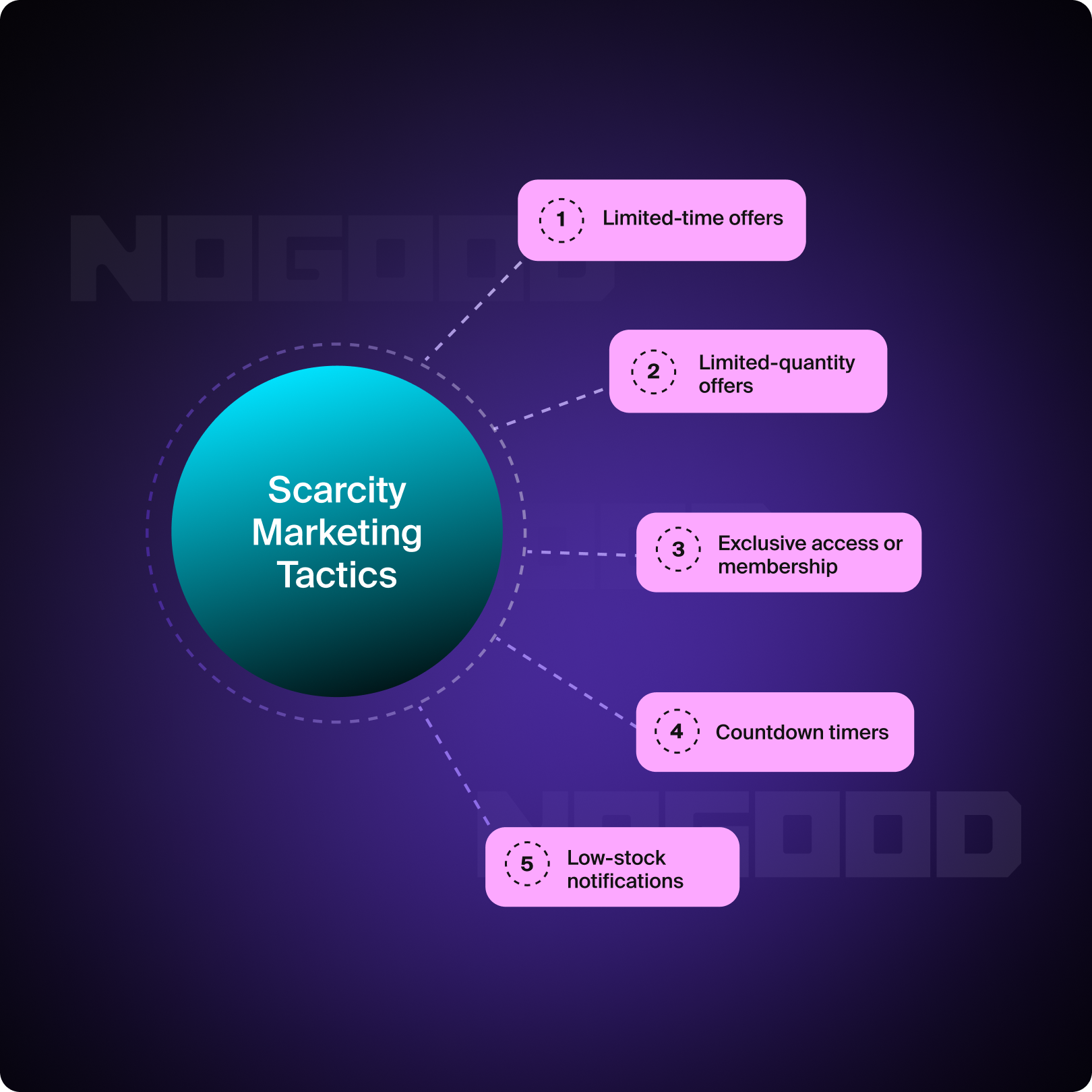
Scarcity is an extremely powerful tool marketers can use to persuade potential customers to convert. It’s based on the idea that if something is in a limited quantity, people will be more likely to buy it.
We see this all the time with limited edition items or “drops” from exclusive brands like Supreme or Yeezy.
Though, It’s not just exclusive brands who can take advantage of this phenomenon, even Amazon uses scarcity to persuade customers to click purchase on the items in their cart, by letting them know that there is a limited quantity left in stock.
If the customer thinks an item or ticket will no longer be available, they’ll be persuaded to take action so they don’t miss out.
Learn more about how to influence consumer behavior with neuromarketing:
How SEO and CRO Work Together
1. User Experience Optimization
The user’s experience on your website determines whether they bounce or convert, directly impacting both Search Engine Optimization and Conversion Rate Optimization results.
If the user clicks on your website and doesn’t find what they are looking for, or they find your website confusing, they are likely to bounce before converting.
CRO practices utilize elements of UX/UI design to ensure the user finds exactly what they are looking for, maximizing the chances of a conversion. These principles also benefit SEO by encouraging the user to stay on the page for longer.
Through intuitive navigation, clear page structure, simple CTAs, and responsive design, CRO and SEO work together to deliver the right information to the right person at the right time.
2. Conversion Funnels
SEO practices bring the user to the page then CRO leads them to make an action like subscribing to an email list, purchasing an item, or downloading a free guide.
Through keyword research and content creation, we can create helpful content that not only gets the user to click on our page but encourages them to continue reading and spending time on our site. We can distribute CRO elements like CTAs, downloadable guides, and email sign-ups throughout the page using clever copy and design choices.
With CRO elements, we can move the user from top of the funnel pages like a blog post to the middle and bottom of the funnel pages like product or service pages and contact forms.
3. Lead Generation
Lead generation allows us to connect with our users through email to remain top of mind, even when they aren’t searching for information or services. SEO and CRO allow us to build relationships with our target audience for when they are ready to convert.
Lead magnets can be distributed throughout blog posts, landing and product pages, in the form of interactive elements like quizzes, forms, and sliders. These interactive elements don’t just capture emails, they also invite users to learn more about products and services we can offer them.
4. Creating Brand Awareness
SEO and CRO work together to promote brand awareness by getting the user to visit and interact with the website.
By encouraging the user to visit our site and read content, interact with forms and quizzes, and learn more about products and services, we create brand awareness even if the user doesn’t convert. Each time they see our page in search results, they’ll become more familiar with our brand and what we can offer them.
How to Align SEO and CRO Goals
Aligning SEO and CRO goals starts with understanding how users engage and move past the awareness stage. By joining SEO and CRO goals, you’ll be focused on the holistic effort of simultaneously improving your organic website traffic and reducing the friction for the user to convert. This makes your digital marketing efforts much more effective since good SEO doesn’t always mean high conversion rate.
1. Lean Towards Simplicity
The more complex something is, the more friction it creates, reducing the probability of a conversion. Fonts, navigation, color scheme, and informational content such as descriptions should be as simple as possible.
As marketers, we often want to include industry jargon to help us create helpful content and establish authority in our niche. However, this can get confusing for the user. We want to ensure our content is easy to navigate and understand to maximize our chances of conversion.
Our SEO practices make our content discoverable and encourage users to click on our site. Simplicity will ensure they continue on the page. If the navigation is confusing or the descriptions are too complex, users are likely to bounce before converting.
When optimizing for SEO, it’s tempting to pile on relevant keywords and helpful content onto the page, but this isn’t always the best for CRO as the user may get lost and not end up where you want them to go. It can be helpful to prioritize the most essential elements, only giving the user the information you need them to know. This practice can work to ensure the user takes the desired action, leading to a conversion.
Elements to consider for increased simplicity:
- Infographics and images that reinforce overarching concepts
- FAQs with an accordion drop-down
- Simple language in CTAs and descriptions
- Prioritize the most essential elements – only give the user the information you need them to know
2. Focus on the User Experience
SEO and CRO are both heavily tethered to user experience. Helpful and informative SEO content encourages users to stay on our site for longer. While they are on our site, our CRO practices guide them toward other pages and lead to a conversion.
Once we get users to our site, we want to make sure they find the information helpful so they continue scrolling through our site instead of bouncing.
As users trend toward more cellphone usage, mobile search traffic continues to climb, so it’s important to add responsive design elements to your website and test your navigation and blog posts on both mobile and desktop.
Improving user experience with SEO & CRO:
- Sticky sidebar navigation with jump links for each section of a blog post
- Create persona and customer journey maps to tailor your content to your ideal audience
- Intuitive navigation for contact forms, add to cart, and checkout pages
- Interactive elements like quizzes, forms, and sliders improve user engagement
3. Conduct A/B Testing
While A/B testing is a classic CRO move, it also applies to SEO.
Conducting A/B tests can help determine the efficacy of your CTA copy, keywords, content structure, and website navigation. We recently ran A/B testing on a few of our marketing agency listicles on the NoGood blog to see if we could increase our conversion rates.
For Variation A we did a content optimization of the page but did not change the format. For Variation B, we optimized the blog and changed the format by placing key information about each agency vertically next to the company logo as opposed to horizontally at the bottom of each section, like Variation A.
After running this test, we found that this change increased conversions, as we hypothesized. What we weren’t expecting was that this would also improve our organic sessions, CTR, and average position.
Here are some CRO and SEO A/B tests to try:
- Landing page variations
- CTA copy and placement on the page
- Horizontal vs vertical navigation
- Semantically related keyword variations
Creating an A/B testing roadmap
An A/B testing roadmap is a document used to track your A/B tests and their results. Your map can help you outline challenges and user pain points and plan how you’ll address them in your testing.
Here are some components to include in your A/B testing roadmap:
- Test Name: Create clear naming conventions so you don’t get your tests mixed up
- Location: Where on your site this test will take place
- Funnel Stage: Consider the user’s funnel stage to determine the copy and elements you’ll use
- Value: How much value will this bring to your users
- Importance: How important is this test to your overall strategy
- Background: Provide some context on why you’re running this test
- Hypothesis: Explain what you hope to accomplish with this test
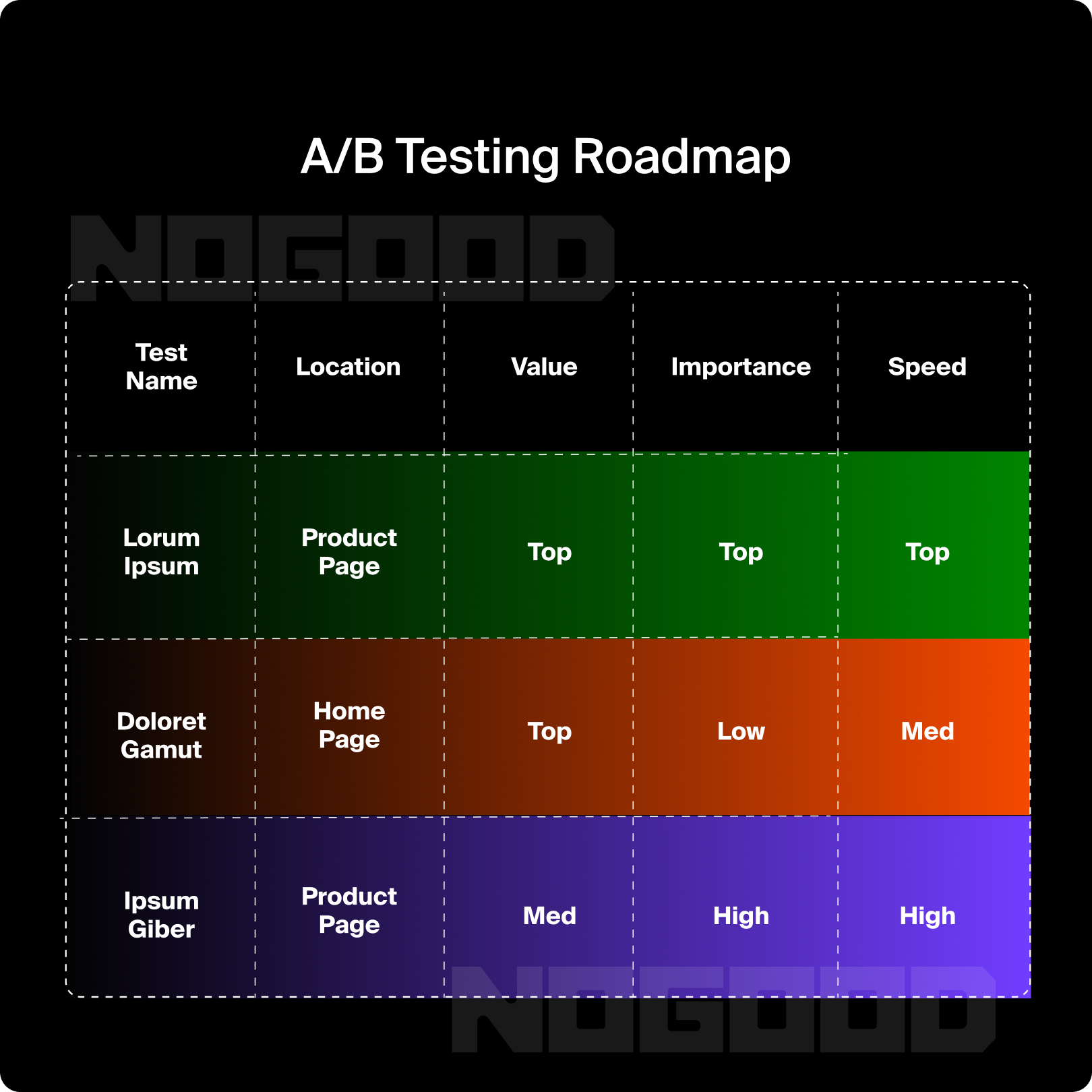
4. Focus on Keyword Intent
Keyword intent major determinant for what type of users will make it onto your page. If you’re creating SEO driven content that is attracting the wrong audience, your content won’t lead to conversions.
The keywords you target in your blog posts match the search intent of your target audience. Let’s say a B2B SaaS company needs more conversions for their new service, so they decide to create more blog content in order to generate leads. When conducting keyword research for their blog posts, they’ll want to consider the user intent for each keyword.
Each keyword will fall under four intent types:
- Informational: The user wants to learn about a topic
- Navigational: The user wants to find a specific page or website
- Commercial: The user wants to learn about products and services
- Transactional: The user wants to make a purchase
Since our SaaS company wants to generate leads through blog content, they’ll want to target keywords with informational intent. If they want to optimize their product or service pages, they can target keywords with commercial and transactional intent.
Creating and optimizing content around keyword intent helps to align SEO and CRO goals by ensuring that you are not only increasing organic traffic but you’re attracting users that have a high chance of converting.
5. Unify Your Measurement
SEO and CRO each have their own metrics, so in order to align your goals, you need to determine how you’ll measure success.
Metrics to track to align SEO and CRO goals:
- Heat maps: Visualize where users are interacting on the page. A ‘hot’ CTA will appear red, meaning that a lot of users are clicking through. If the CTA appears blue, users aren’t clicking as much, signifying revision is needed.
- Scroll depth: Measures how far down the page the user continues to scroll before making an action.
- Dwell time: Tells you the amount of time user spend on the page before bouncing or converting
- CTR: Click-through rate helps determine if users are converting by clicking the links on your page
- CAC: Tracking customer acquisition costs ensures you’re staying in the profit with your CRO and SEO efforts
6. Create a Clear Path for Users
When a user arrives on your site there should be a clear path of actions they should take that leads them through the funnel stages and ends in the desired action. With SEO and CRO, you can create a clear internal linking path that controls the user’s journey and directs them to relevant content that facilitates conversion.
It can be helpful to reference the persona and user journey maps you created to address the user’s interests and pain points. Consider the problems the user has, and how your product or service can solve them.
Creating a user path with click funnels:
- Optimize your landing page to capture the user’s attention
- Promote product awareness by inviting the user to learn more about your products or services
- Nurture leads through interactive elements like quizzes, forms, or sliders
- Add a lead magnet to connect with users through email
- Optional: Offer an introductory package or promotion
Final Thoughts
Combining SEO and CRO for growth is ultimately a long term strategy. It requires strategic planning and coordination to align your conversion goals and conduct testing to find out what works for your audience and your business goals.
When uniting two different digital marketing strategies for the same goal, it can be difficult to find your north star. If you need help aligning your SEO and CRO strategies to maximize your growth, we have growth experts who can help, feel free to drop us a line.




